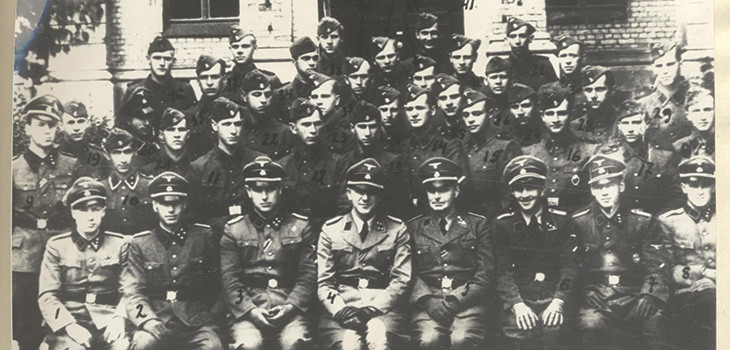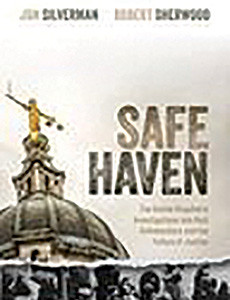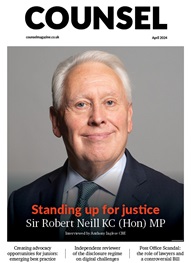*/

Delving into Britain’s investigations of Nazi collaborators who found refuge in the UK after WWII, Jon Silverman reveals previously undisclosed criteria which severely restricted the possibility of prosecutions
The War Crimes Act, passed after much controversy in 1991, presented British lawyers with an unprecedented challenge: how to fit the crimes of the Holocaust into a common law template of justice more than 70 years later. In the event, the challenge was sidestepped. When considering cases, Treasury Counsel and the Crown Prosecution Service declined to deviate from the normative requirements of a murder prosecution. Without forensic evidence, for obvious reasons, they relied on incontrovertible identification of a defendant and live eye witnesses prepared to testify in open court. Documentary testimony gathered contemporaneously by NKVD investigators after the war was largely eschewed, no matter how probative. The outcome was that, out of 274 suspects investigated by the police, only one conviction was obtained. The title of our book, Safe Haven, refers to the sanctuary many mass murderers found in the UK, disturbed only towards the end of their lives by a visit or two to a police station and a letter from the CPS telling them that there was insufficient evidence to take the matter further.
Many of those practising at the Bar may well say that this is the price of conforming to precedent in a system of jury-based justice. Why should exceptions have been made even when dealing with the greatest act of mass murder of the 20th century? But delve a little further, as we have, and you find that certain exceptions were made, some never disclosed and others only made public at the tail end of the investigative process.
For example, a confidential decision was taken to limit potential prosecutions to those cases where the victims were Jewish civilians, excluding the myriad of killings committed against the non-Jewish populations of Eastern Europe. Senior Treasury Counsel, Sir John Nutting, KC, justified this approach by saying:
We felt it would have unnecessarily complicated the prosecution because such crimes [against non-Jewish civilians] would have been called war reprisals.
Another factor which undermines the claim that these were normative charging decisions was the imposition of an arbitrary threshold: only those who had been ‘in a position of command’ would face the prospect of trial. This criterion cannot be found in the War Crimes Act and runs counter to the principle, established at Nuremberg, that obeying orders was not an adequate defence. William (Bill) Clegg KC, who defended Andrzej Sawoniuk, the only person to be convicted, told us:
I thought it [the command criterion] was a sensible decision because there were never going to be many trials and the prosecution was aware of how a jury might react to a foot soldier being tried.
However, this argument is weakened by examining the charges against Sawoniuk and the evidence presented at his trial which inculpated him on the strength of his own individual responsibility – including the machine gun murder of 15 Jewish women – and not because he held a command role. Furthermore, the former head of War Crimes Casework at the CPS, Rajka Vlahovic, has confirmed that the issue of command responsibility played no part in the evidence adduced at trial.
Perhaps the most consequential decision taken by the Crown was to hold an ‘old-style’ full committal in the prosecution of the first person to face charges, Szymon Serafinowicz. The Hetherington-Chalmers inquiry which recommended the law change that led to the War Crimes Act, made the very strong point that potential defendants and witnesses would be elderly and quite possibly in frail health and that therefore speed would be of the essence in bringing cases to trial. To this end, the inquiry advocated that ‘the procedure of transfer to the Crown Court [should be] without any committal proceedings.’
This recommendation was rejected. Nutting’s justification was that these were unique cases and it would benefit both prosecution and defence if the evidence was fully tested before a stipendiary magistrate ahead of a trial. Serafinowicz was already 84, though in reasonable health, when he was charged in July 1995. The committal in 1996 lasted six weeks and was followed later in the year by an abuse of process challenge. By early 1997 when an Old Bailey trial was scheduled, the defendant had developed Alzheimer’s and was found unfit to instruct his legal team. The prosecution collapsed. Nutting told us:
We didn’t anticipate that Serafinowicz would put forward a defence that he was unfit to stand trial but if the charge is that we bent over backwards to favour the defendant I can live with that. And if people say ‘he got away with it’, one could reply that it also deprived us of a possible conviction.
Had the Crown acted with more urgency, Serafinowicz could have been charged far earlier than he was. All of the substantive evidence had been gathered by the Spring of 1995 and the CPS was satisfied that it had a solid case to submit to the Attorney-General, who alone could authorise a charge. But according to the former head of War Crimes Casework at the CPS, Paul Harrison, no decision was made for several months:
The AG [Sir Nicholas Lyell] sat on it for some time, perhaps because he couldn’t make up his mind. The particular reason for the delay though was that he wanted a number of extra checks made. But I stress that no more information was added to the file whatsoever after I submitted it.
Despite the flawed decision-making, at least it can be said that the Serafinowicz case resulted in a charge. Another suspect, a Latvian living in Milton Keynes, did not even suffer that indignity. Harijs Svikeris had been a senior officer in the Arãjs Kommando, a notorious antisemitic, nationalist militia which aided the Nazis in exterminating the Jewish population of Latvia. When the War Crimes Act became law in 1991 there were expectations that he would be the first person to be charged. After he retired as the first head of Scotland Yard’s war crimes unit, Detective Chief Superintendent Eddie Bathgate, told me:
Svikeris was a powerful case and I would cheerfully have put him on the charge sheet. The more we investigated him, the stronger the case got. There was no dispute about identification, he was a volunteer and admitted during the interviews that he was present when massacres took place, without an actual confession of guilt… but the CPS wouldn’t move off the fence and make a recommendation to prosecute.
Their reluctance was largely because surviving cohort witnesses from Svikeris’s platoon could not be persuaded to testify at the Old Bailey that they had seen him kill, and despite strong evidence gathered at the end of the war and later.
This is also a story about a palpable lack of transparency. Neither Scotland Yard nor the CPS published a final report on the war crimes inquiries relating to World War II. Had they done so, some of the issues raised in this article might have been addressed at the time. The sad truth is that the due process of law denied to their victims by the Nazis and their collaborators shielded many of the perpetrators to the bitter end.


The War Crimes Act, passed after much controversy in 1991, presented British lawyers with an unprecedented challenge: how to fit the crimes of the Holocaust into a common law template of justice more than 70 years later. In the event, the challenge was sidestepped. When considering cases, Treasury Counsel and the Crown Prosecution Service declined to deviate from the normative requirements of a murder prosecution. Without forensic evidence, for obvious reasons, they relied on incontrovertible identification of a defendant and live eye witnesses prepared to testify in open court. Documentary testimony gathered contemporaneously by NKVD investigators after the war was largely eschewed, no matter how probative. The outcome was that, out of 274 suspects investigated by the police, only one conviction was obtained. The title of our book, Safe Haven, refers to the sanctuary many mass murderers found in the UK, disturbed only towards the end of their lives by a visit or two to a police station and a letter from the CPS telling them that there was insufficient evidence to take the matter further.
Many of those practising at the Bar may well say that this is the price of conforming to precedent in a system of jury-based justice. Why should exceptions have been made even when dealing with the greatest act of mass murder of the 20th century? But delve a little further, as we have, and you find that certain exceptions were made, some never disclosed and others only made public at the tail end of the investigative process.
For example, a confidential decision was taken to limit potential prosecutions to those cases where the victims were Jewish civilians, excluding the myriad of killings committed against the non-Jewish populations of Eastern Europe. Senior Treasury Counsel, Sir John Nutting, KC, justified this approach by saying:
We felt it would have unnecessarily complicated the prosecution because such crimes [against non-Jewish civilians] would have been called war reprisals.
Another factor which undermines the claim that these were normative charging decisions was the imposition of an arbitrary threshold: only those who had been ‘in a position of command’ would face the prospect of trial. This criterion cannot be found in the War Crimes Act and runs counter to the principle, established at Nuremberg, that obeying orders was not an adequate defence. William (Bill) Clegg KC, who defended Andrzej Sawoniuk, the only person to be convicted, told us:
I thought it [the command criterion] was a sensible decision because there were never going to be many trials and the prosecution was aware of how a jury might react to a foot soldier being tried.
However, this argument is weakened by examining the charges against Sawoniuk and the evidence presented at his trial which inculpated him on the strength of his own individual responsibility – including the machine gun murder of 15 Jewish women – and not because he held a command role. Furthermore, the former head of War Crimes Casework at the CPS, Rajka Vlahovic, has confirmed that the issue of command responsibility played no part in the evidence adduced at trial.
Perhaps the most consequential decision taken by the Crown was to hold an ‘old-style’ full committal in the prosecution of the first person to face charges, Szymon Serafinowicz. The Hetherington-Chalmers inquiry which recommended the law change that led to the War Crimes Act, made the very strong point that potential defendants and witnesses would be elderly and quite possibly in frail health and that therefore speed would be of the essence in bringing cases to trial. To this end, the inquiry advocated that ‘the procedure of transfer to the Crown Court [should be] without any committal proceedings.’
This recommendation was rejected. Nutting’s justification was that these were unique cases and it would benefit both prosecution and defence if the evidence was fully tested before a stipendiary magistrate ahead of a trial. Serafinowicz was already 84, though in reasonable health, when he was charged in July 1995. The committal in 1996 lasted six weeks and was followed later in the year by an abuse of process challenge. By early 1997 when an Old Bailey trial was scheduled, the defendant had developed Alzheimer’s and was found unfit to instruct his legal team. The prosecution collapsed. Nutting told us:
We didn’t anticipate that Serafinowicz would put forward a defence that he was unfit to stand trial but if the charge is that we bent over backwards to favour the defendant I can live with that. And if people say ‘he got away with it’, one could reply that it also deprived us of a possible conviction.
Had the Crown acted with more urgency, Serafinowicz could have been charged far earlier than he was. All of the substantive evidence had been gathered by the Spring of 1995 and the CPS was satisfied that it had a solid case to submit to the Attorney-General, who alone could authorise a charge. But according to the former head of War Crimes Casework at the CPS, Paul Harrison, no decision was made for several months:
The AG [Sir Nicholas Lyell] sat on it for some time, perhaps because he couldn’t make up his mind. The particular reason for the delay though was that he wanted a number of extra checks made. But I stress that no more information was added to the file whatsoever after I submitted it.
Despite the flawed decision-making, at least it can be said that the Serafinowicz case resulted in a charge. Another suspect, a Latvian living in Milton Keynes, did not even suffer that indignity. Harijs Svikeris had been a senior officer in the Arãjs Kommando, a notorious antisemitic, nationalist militia which aided the Nazis in exterminating the Jewish population of Latvia. When the War Crimes Act became law in 1991 there were expectations that he would be the first person to be charged. After he retired as the first head of Scotland Yard’s war crimes unit, Detective Chief Superintendent Eddie Bathgate, told me:
Svikeris was a powerful case and I would cheerfully have put him on the charge sheet. The more we investigated him, the stronger the case got. There was no dispute about identification, he was a volunteer and admitted during the interviews that he was present when massacres took place, without an actual confession of guilt… but the CPS wouldn’t move off the fence and make a recommendation to prosecute.
Their reluctance was largely because surviving cohort witnesses from Svikeris’s platoon could not be persuaded to testify at the Old Bailey that they had seen him kill, and despite strong evidence gathered at the end of the war and later.
This is also a story about a palpable lack of transparency. Neither Scotland Yard nor the CPS published a final report on the war crimes inquiries relating to World War II. Had they done so, some of the issues raised in this article might have been addressed at the time. The sad truth is that the due process of law denied to their victims by the Nazis and their collaborators shielded many of the perpetrators to the bitter end.

Delving into Britain’s investigations of Nazi collaborators who found refuge in the UK after WWII, Jon Silverman reveals previously undisclosed criteria which severely restricted the possibility of prosecutions


Sam Townend KC explains the Bar Council’s efforts towards ensuring a bright future for the profession
Giovanni D’Avola explores the issue of over-citation of unreported cases and the ‘added value’ elements of a law report
Louise Crush explores the key points and opportunities for tax efficiency
Westgate Wealth Management Ltd is a Partner Practice of FTSE 100 company St. James’s Place – one of the top UK Wealth Management firms. We offer a holistic service of distinct quality, integrity, and excellence with the aim to build a professional and valuable relationship with our clients, helping to provide them with security now, prosperity in the future and the highest standard of service in all of our dealings.
Is now the time to review your financial position, having reached a career milestone? asks Louise Crush
If you were to host a dinner party with 10 guests, and you asked them to explain what financial planning is and how it differs to financial advice, you’d receive 10 different answers. The variety of answers highlights the ongoing need to clarify and promote the value of financial planning.
Most of us like to think we would risk our career in order to meet our ethical obligations, so why have so many lawyers failed to hold the line? asks Flora Page
If your current practice environment is bringing you down, seek a new one. However daunting the change, it will be worth it, says Anon Barrister
Creating advocacy opportunities for juniors is now the expectation but not always easy to put into effect. Tom Mitcheson KC distils developing best practice from the Patents Court initiative already bearing fruit
National courts are now running the bulk of the world’s war crimes cases and corporate prosecutions are part of this growing trend, reports Chris Stephen
Let’s hear it for the assessors, says Dame Anne Rafferty of the KC Selection Panel. And to make silk assessors’ lives a little easier when applicants come calling in May, Dame Anne fields some commonly asked questions